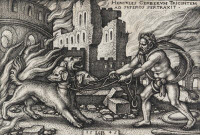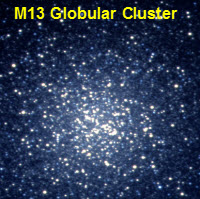The origin and true identity of this constellation was lost even to the ancient Greeks, who knew the figure as Engonasi, which literally means ‘the kneeling one’. It was Eratosthenes who identified the figure as Heracles (the Greek name for Hercules) in the 3rd century BC.
Mythology
In Greek mythology Hercules was the illicit son of Zeus and the beautiful mortal women, Alcmene, whom Zeus visited in the guise of her husband, Amphitryon. The infant Hercules became immortal, after he suckled milk from the goddess Hera, Zeus’s real wife, who was asleep at the time. Once Hera learned of the truth, she was outraged and vowed to make Hercules' life as uncomfortable as possible.
Under Hera’s evil spell Hercules killed his own children in a fit of madness, and in an effort to atone for his dreadful deed when sanity returned, was ordered by the Oracle at Delphi to serve Eurystheus, King of Mycenae, for 12 years. In total Eurystheus set him a series of 12 tasks that are called 'the Labours of Heracles'.

The Twelve Labours of Hercules
The first was to kill a lion that was terrorising the land around the City of Nemea. This lion had a hide that was impervious to any weapon, so Heracles strangled it to death. The Nemean lion is identified with the constellation Leo.
 His second labour was to kill the multi-headed monster Hydra, a pet raised by Hera from birth. The monster inhabited a swamp near the town of Lerna, and as Hercules found out, could regenerate heads – as one was cut off two would replace it. Hercules called for help from his charioteer, Iolaus, who helped cauterise the head stumps before they could regenerate. On seeing that her pet monster was in trouble, Hera sent a giant crab to attack Hercules whilst fighting the Hydra, but the crustacean was crushed by Hercules, stamping on the crab. Hercules dipped his arrows in the Hydra’s poisonous blood, an action that would eventually be his undoing. A distraught Hera placed both the crab (Cancer) and the Hydra in the heavens.
His second labour was to kill the multi-headed monster Hydra, a pet raised by Hera from birth. The monster inhabited a swamp near the town of Lerna, and as Hercules found out, could regenerate heads – as one was cut off two would replace it. Hercules called for help from his charioteer, Iolaus, who helped cauterise the head stumps before they could regenerate. On seeing that her pet monster was in trouble, Hera sent a giant crab to attack Hercules whilst fighting the Hydra, but the crustacean was crushed by Hercules, stamping on the crab. Hercules dipped his arrows in the Hydra’s poisonous blood, an action that would eventually be his undoing. A distraught Hera placed both the crab (Cancer) and the Hydra in the heavens.
For his next two labours, Hercules was ordered to catch elusive animals: a deer with golden horns, and a ferocious boar. For his fifth labour Hercules cleaned the dung filled stables of King Augeias of Elis in one day by diverting two rivers. For his sixth task he dispersed a flock of marauding birds with arrow-like feathers, the survivors of which flew to the Black Sea, where they subsequently attacked Jason and the Argonauts.
Hercules then sailed to Crete to capture a fire-breathing bull that was ravaging the land, before ensnaring the flesh-eating horses of King Diomedes of Thrace and then delivering the Belt of Hippolyte, Queen of the Amazons to Eurystheus for his ninth task.
For his 10th task Hercules was sent to steal the cattle of Geryon, a triple-bodied monster who ruled the Island of Erytheia, far to the west. En-route, Hercules set up the columns at the Straits of Gibraltar called the Pillars of Heracles. The image of which is depicted on the famous Spanish pieces of eight coins. Geryon with dispatched with a single arrow that pierced all three bodies from the side.
Refusing to release Hercules from his service, because he had received help killing the Hydra, Eurystheus set him two additional tasks. The first was to steal the golden apples from the garden of Hera on the slopes of Mount Atlas, guarded by the Dragon Ladon. Hercules dispatched Ladon with a well-aimed arrow, and then asked Atlas who was stood nearby holding up the sky, to pick and fetch the apples - Hercules temporarily performing Atlas’s job. A furious Hera set the dragon in the sky as the constellation Draco.
 The twelfth labour, the most daunting of all, took him down to the gates of the Underworld to fetch Cerberus, the three-headed watchdog. Cerberus had the tail of a dragon and a snake covered back. Hercules utilised the pelt of the Nemean lion to protect himself, whilst wrestling with Ceberus, dragging the slavering dog to the startled King Eurystheus, who never expected to see Hercules alive. With all his labours completed, Eurystheus had no option but to make Hercules a free man again.
The twelfth labour, the most daunting of all, took him down to the gates of the Underworld to fetch Cerberus, the three-headed watchdog. Cerberus had the tail of a dragon and a snake covered back. Hercules utilised the pelt of the Nemean lion to protect himself, whilst wrestling with Ceberus, dragging the slavering dog to the startled King Eurystheus, who never expected to see Hercules alive. With all his labours completed, Eurystheus had no option but to make Hercules a free man again.
After his labours, Heracles married Deianeira, the young and beautiful daughter of King Oeneus. Whilst travelling, Hercules and Deianeira reached the river Evenus, across which where the centaur, Nessus, ferried passengers. The centaur, aroused by her beauty, tried to ravish her and Hercules shot him with an arrow tipped with the Hydra’s poison. The dying centaur offered Deianeira some of his blood, deceitfully claiming that it would act as a love charm. She accepted, keeping it safe until much later when she suspected Hercules was ‘seeing’ another woman. Deianeira gave Hercules a shirt on which she had smeared the blood of the dying Nessus, hoping to win back his affection. When Hercules put it on, the Hydra’s poison began to burn his flesh to the bone. Realising there was no release from the pain, Hercules built himself a funeral pyre on Mount Oeta, laid down on it and as the flames burned up the mortal part of him, the immortal part ascended to join the gods on Mount Olympus, where Zeus, turned placed him in the sky.

The Constellation
Considering Hercules is regarded as perhaps the greatest of Greek and Roman heroes, it is surprising that the constellation, although the 5th largest in the sky, is rather inconspicuous and ill defined, apart from the ‘keystone’ asterism. It contains no 1st or 2nd magnitude stars, but it does contain some fine deep sky objects –in particular M13. The more important or brighter star members are as follows.

Constellation of Hercules
Alpha Herculis or Rasalgethi, from the Arabic meaning ‘the kneeler’s head’, is a red giant star that varies from third to fourth magnitude. It is actually a triple star system some 359 light-years distant, the main components of which can be separated in amateur telescopes. The primary is variable (mag 3 – 4) and is roughly of 400 solar diameters. The secondary, a spectroscopic binary that orbits the primary every 3600 years, is a blue-green hued star of magnitude 5.6.
Beta Herculis, named Kornephoros, and Sarin, mark his right and left shoulders respectively. Beta or Kornephoros is the constellation’s brightest star, a yellow giant star situated around 140 light years away with a visual magnitude of 2.81. It is actually a binary system, the primary yellow component sum 17 times the diameter of our sun, three times its mass, and shines 175 times brighter. The two stars have an orbital period of 410 days. Sarin (Delta Herculis), is the 3rd brightest star, a multiple star system located 75 light years distant with a magnitude of 3.1. Its primary star is a white sub-giant with twice the Sun‘s radius and mass.
The 2nd brightest star is Zeta Herculis, a multiple star system found 35 light years away with a visual magnitude of 2.81. Its main component star is a subgiant with 2.6 times the Sun’s radius, 1.45 times its mass, and 6 times its luminosity, while its companion is a yellow dwarf not unlike our own sun.
 The four stars Epsilon, Zeta, Eta, and Pi Herculis form a distinctive quadrilateral asterism known as the Keystone that outlines the pelvis of Hercules. Pi Herculis and Zeta Herculis are both 3rd magnitude, Epsilon and Eta Herculis are both 4th magnitude. His left leg, with Theta Herculis as the knee and Iota Herculis as the lower shin, press on the head of the vanquished Dragon, Draco. n. Hercules rests on his right knee (Tau Herculis).
The four stars Epsilon, Zeta, Eta, and Pi Herculis form a distinctive quadrilateral asterism known as the Keystone that outlines the pelvis of Hercules. Pi Herculis and Zeta Herculis are both 3rd magnitude, Epsilon and Eta Herculis are both 4th magnitude. His left leg, with Theta Herculis as the knee and Iota Herculis as the lower shin, press on the head of the vanquished Dragon, Draco. n. Hercules rests on his right knee (Tau Herculis).
Other stars of interest in Hercules include the orange giant 109 Herculis; the blue subgiant Rukbalgethi Shemali (Tau Herculis); the yellow-white giant Nu Herculis; as well as several dwarf stars, including Gliese 649 (red), 14 Herculis (orange), and HD 155358 (yellow).
 The most celebrated object in the constellation is the globular cluster M13, one of the best examples of such a cluster in northern skies. It is visible as a fuzzy star through binoculars, but is a fine sight through a telescope – which can be partly resolved in apertures of 6” and above giving an almost 3D impression.
The most celebrated object in the constellation is the globular cluster M13, one of the best examples of such a cluster in northern skies. It is visible as a fuzzy star through binoculars, but is a fine sight through a telescope – which can be partly resolved in apertures of 6” and above giving an almost 3D impression.
M13 resides around 26000 light years away and contains perhaps half a million stars. The other fine deep sky object is the globular cluster M92 – often overlooked, probably due to the relative proximity of M13. It should not be! It is a pleasing sight through a 6” scope or above.
Other fainter deep sky objects include NGC 6229 is a dimmer globular cluster, with a magnitude of 9.4, NGC 6210 is a planetary nebula of the 9th magnitude, 4000 light-years from Earth and visible as a very small blue-green elliptical disk in amateur telescopes larger than 4” in aperture. The constellation also contains the distant galaxy cluster Abell 2151 and the Hercules–Corona Borealis Great Wall, the largest structure in the universe.
The solar apex, i.e., the point on the sky which marks the direction that the Sun is moving in its orbit around the center of the Milky Way, is located within Hercules, close to Vega in neighbouring Lyra.
- Log in to post comments

